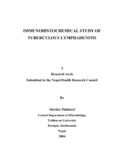Please use this identifier to cite or link to this item:
https://hdl.handle.net/20.500.14356/428Full metadata record
| DC Field | Value | Language |
|---|---|---|
| dc.contributor.author | Nepal Health Research Council (NHRC) | |
| dc.contributor.author | Pokharel, Smritee | |
| dc.date.accessioned | 2013-01-07T20:17:21Z | |
| dc.date.accessioned | 2022-11-08T10:14:55Z | - |
| dc.date.available | 2013-01-07T20:17:21Z | |
| dc.date.available | 2022-11-08T10:14:55Z | - |
| dc.date.issued | 2004 | |
| dc.identifier.uri | http://103.69.126.140:8080/handle/20.500.14356/428 | - |
| dc.description.abstract | This study was conducted at Patan hospital, during September 2002 to March 2003 in joint collaboration with Central Department of Microbiology, Tribhuvan University with the objective to evaluate different staining techniques for the diagnosis of tuberculous lymphadenitis on clinically suspected cases. Altogether, 40 biopsies collected at Department of Pathology, Patan Hospital were further analyzed.40 biopsy specimen were stained with Haematoxylin - Eosin stain and Acid fast stain where as 20 biopsies were stained with CD3/ CD20/ S-100 stains respectively and the biopsy cell/tissue features were analyzed. Among 40 cases of suspected tuberculous lymphadenitis cases, 100% cases show edtuberculosis positive in Haematoxylin-Eosin stain. Where as Acid Fast Bacillicould be detected in only 10% of the cases. Greater prevalence of tuberculous lymphadenitis was observed between 20-30 years of age with higher percentage of female’s involvement. Frequency of Cervical and axillary nodes involvement were higher than other. In 57.5% ofcases, right cervical nodes and in 20% of the cases, axillary nodes were found involved. Multiple nodes involvement was observed in 80% of the cases and bilateral nodes in only20% of the cases. CD3 cells were present in higher numbers than CD20 cells. CD3 cells were confined to paracortical areas where as higher CD 20 cells were found in follicular area. Butdue to migratory nature of CD20 cells, they were also found inother parts of lymph nodes. Immunohistochemical staining techniques, though specific, H-E staining and AFB staining in combination still remains a method of choice for the diagnosis of tuberculous lymphadenitis,in developing country like Nepal, because of cost benefit and availability of immunohisto-chemical staining reagents. | en_US |
| dc.language.iso | en_US | en_US |
| dc.publisher | Nepal Health Research Council | en_US |
| dc.subject | Immunohistochemical study of Tuberculous Lymphadenitis | en_US |
| dc.title | Immunohistochemical study of Tuberculous Lymphadenitis | en_US |
| dc.type | Technical Report | en_US |
| Appears in Collections: | NHRC Research Report | |
Files in This Item:
| File | Description | Size | Format | |
|---|---|---|---|---|
| 440.pdf | Full Report. Download | 2.19 MB | Adobe PDF |  View/Open |
Items in DSpace are protected by copyright, with all rights reserved, unless otherwise indicated.
